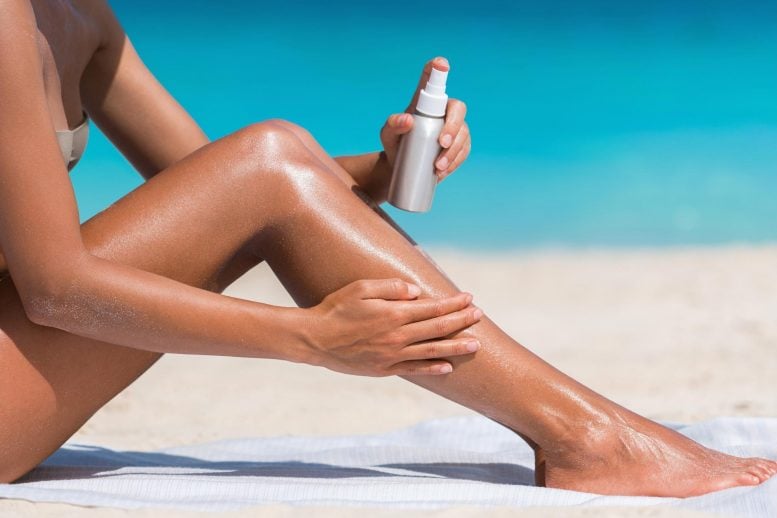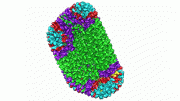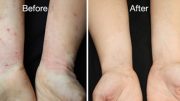
Sunscreen can prevent wrinkles and skin cancer. SPF is based on protection against UVB rays, but it’s important to use a lotion to also shield your skin from UVA.
In the summer, before you head to the beach or pool, you might slather on sunscreen. But is it doing anything beyond preventing a sunburn? Can it really prevent wrinkles and skin cancer?
Video Transcript:
It’s summer. And before you head outside to go to the beach or pool, or just to exist, you slather on sunscreen. But is it doing anything besides preventing a sunburn?
Is it really preventing wrinkles? What about skin cancer?
Commercial sunscreens have been around for almost a century. Before we get into what they do, we need to take a look at why the sun’s rays can give us wrinkles and cancer and make us okay, me, look like a steamed lobster if I’m outside too long.
The sun emits three types of ultraviolet rays; UVA, B, and C. Earth’s ozone layer filters out UVC. It can’t reach us. So that leaves us with UVB and UVA.
UVB rays have a pretty short wavelength, so they can’t reach super deep in your skin. They don’t really get past the top layer, your epidermis, and they are mostly responsible for giving you a sunburn.
How? UV radiation releases compounds like cytokines in your epidermis. And then they travel to the layer below your dermis, where they cause your blood vessels to dilate. So more blood starts flowing through.
That increased blood flow makes white people look pink or red. People with darker skin have more melanin, the brown pigment that can also give you a tan and prevent more skin damage. And that makes it harder to see that increased blood flow.
So there’s this common, very wrong assumption that people with darker skin can’t burn, they can, it’s just harder to see.
It’s probably not so shocking to learn that sunscreens were created with white people in mind. And although more companies are becoming aware of the importance of making sunscreens that are tested and designed for a range of skin colors, they have a long way to go to become inclusive of people with darker skin.
Okay. Back to the sun. When UVB radiation hits your skin, it causes more than just a sunburn. It causes DNA damage, and that can lead to skin cancer.
Let’s break that down, starting with a quick bio 101 reminder.
Your DNA has four types of nucleotides: adenine, cytosine, guanine, and thymine.
One really common way that UVB damages your DNA is by causing cytosine to bind to a cytosine next door or thymine to bind to a thymine next door, forming structures called cyclobutane pyrimidine dimers, or CPDs.
Here’s a CPD formed when two thymines next to each other become covalently bonded.
CPDs warp the structure of your DNA so much that enzymes and other cell machinery can’t read it and transcribe it into RNA.
So your body tries to fix the damage by removing the bit of damaged DNA and then rebuilding it by reading the opposite DNA strand and bringing back in the correct nucleotides. But the repair process isn’t perfect and can lead to mutations.
Most mutations are harmless, but if the mutation happens in a gene that controls cell growth, for example, P53, that can cause your cells to start dividing uncontrollably, which can lead to cancer.
UVA rays can also cause cancer, but not directly like UVB.
Both UVA and UVB can lead to the production of chemicals called reactive oxygen species, which can add an oxygen atom to your DNA.
One example is the DNA nucleotide guanine being oxidized to 8-oxo-7,8-dihydroguanine, which makes it harder for it to pair with cytosine, the nucleotide it’s supposed to pair with.
Again, this damage can lead to cells that are dividing out of control.
Most of the sun’s rays that reach the ground are UVA. UVA are longer wavelength, which allows them to reach deeper into our skin, to the dermis, where they trigger cells called melanocytes to produce melanin and also cause wrinkles.
Yes, over time, everyone gets wrinkles, but UV radiation, particularly UVA, can really speed up that process by increasing the production of enzymes called metalloproteinases, that degrade, collagen and elastin—fibers in your dermis that provide yourselves with structural support and allow your skin to stretch and spring back without your skin getting damaged.
Less collagen and elastin can lead to wrinkles and leathery skin.
Other studies have found that elastin production can actually increase after UV exposure, but the elastin produced is abnormal. So skin isn’t rebuilt the same way and that can also lead to wrinkles.
So where does sunscreen come in?
Let’s first look at how it works through a sunscreen ingredient that’s pretty common in the US, oxybenzone.
When a UV photon hits a molecule of oxybenzone on your skin, the oxybenzone molecule absorbs the photon and gains energy.
One of the bonds linking the two rings together rotates, dissipating a lot of the energy and smacking the ring on the right into another molecule on your skin, which often happens to be water.
The water molecule absorbs the energy. So it vibrates, which makes it a bit hotter. Then the bond rotates back, bringing us to about where we started, ready to absorb more UV photons.
Overall, oxybenzone absorbed a photon of UV radiation—a photon that might have otherwise damaged your DNA—and dissipated that photon’s energy as harmless heat.
The oxybenzone can’t effectively absorb photons forever, plus sunscreen can rub or wash off. So that’s why dermatologists say to reapply every couple of hours, even more frequently, if you’re swimming.
It’s important to note that oxybenzone is being phased out in a bunch of places, including Hawaii, because it’s safety for coral reefs is being questioned.
Also the FDA recently said that oxybenzone and other organic active ingredients like these can be absorbed by our bodies, especially if you use sunscreen every day.
So they’re asking manufacturers to do more safety studies on these ingredients.
In the meantime, sunscreens that used zinc oxide or titanium dioxide works similarly to oxybenzone and the FDA has said they’re safe.
So I personally always stick with those.
Now can sunscreen prevent wrinkles and cancer?
Well, if sunscreen blocks most UV rays, which we know can cause wrinkles and skin cancer, I want to say, yes.
There’s not actually much data on this, but here’s what we know. In terms of wrinkles and skin cancer, there’s only one major randomized controlled trial that’s been done.
In the nineties, researchers in Australia followed 903 adults over the course of four and a half years and found that people who use sunscreen every day showed no detectable increase in skin aging based on latex skin impressions they took of the backs of their hands. They also found that it reduced the risk of some types of skin cancer.
So where does that leave us?
Although the data is limited, it does indicate that sunscreen can prevent wrinkles and skin cancer and sunscreens have become much more protective since that trial was done, which is only a good thing.
Plus logic tells us that UV rays kept from getting into your skin can’t harm your skin.
Most dermatologists will tell you to wear sunscreen, but that it’s only part of the equation. Not all sunscreens are created equal, even ones with the same SPF.
SPF is based on protection against UVB rays, but it’s important to use a lotion. That’ll also shield your skin from UVA. So look for that. And avoiding peak sun exposure hours and wearing protective clothing and hats are also an important addition to lathering up.









OK, this info is good as far as it goes. But it mentions just the one study and just 3 possible sunscreen ingredients (oxybenzone, titanium oxide and zinc oxide). There are many other ingredients which appear to be harmful, in particular clear spray-type sunscreens contain nano particles which enter the bloodstream and can get into your lungs or pass through the blood brain barrier into your brain.
It’s kind of strange that melanin and tanning don’t work in the opposite direction: too much sun makes whiter skin to raise albedo. If everything else had the same shift, then it would still fit in with seasonal camouflage.
Given the complexity of today’s world, it’d help by declaring conflict of interests especially as you seem to promote the use of sunscreen products.